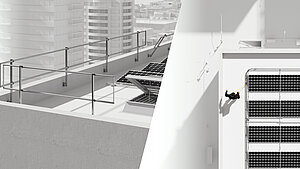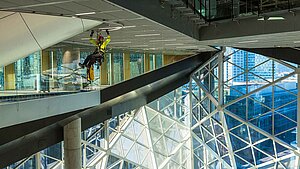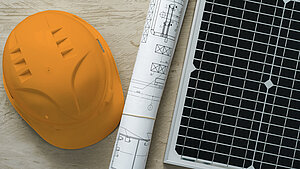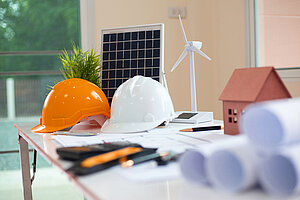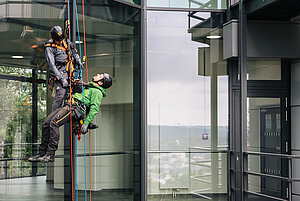Anti-fall PPE: What is that?
Personal protective equipment against falls from a height, anti-fall PPE for short, is one of the individual protective measures of fall protection - in brief: individual protection. It represents the secured connection between the actual safety system and the maintenance or service worker, i.e. the user of the system. The purpose of what are often known as “safety harnesses” in everyday language is to intercept people who are falling, and to ensure that the forces which this generates remain within safe limits (or else, by means of restraint, to prevent the fall from even occurring in the first place).
However, the anti-fall PPE does not consist solely of the restraint or safety harness. In addition to the harness, the following are also included:
- Helmet
- Rope
- Carabiner
- Ascenders
- Lanyards (with integrated shock absorber), for example)
Especially for workplaces where there is a fall risk - on wind, water and solar power generators, or on roofs and facades, for example - it is essential that a professional, certified fall protection system is deployed at the location, because these workplaces at height are amongst the most dangerous anywhere.
After the fall - before what is known as suspension trauma sets in - the people who have fallen must be rescued immediately, because extended suspension without movement can result in irreversible physical injury and even death.
The PPE consists not only of the safety or restraint harness, as is often unfortunately assumed. Lanyards for workplace positioning, helmets, carabiners, energy absorbers etc. are part of the necessary equipment for protecting against falls.
Personal fall protection systems always require an anchorage device
Permanent anchorage devices and fall arrest systems, for example in the form of lifeline or rail protection on a roof - but also including a temporary lifeline system (!) - can be used only in combination with anti-fall PPE to protect against life-threatening falls. Here, it should always be ensured that the anti-fall personal protective equipment perfectly matches the respective anchorage device and that it does not impede the workers in carrying out their work. In addition, the safety or restraint harness should sit comfortably and conveniently, so that nothing squeezes or cuts in. Naturally, all components should be appropriately certified, and inspected regularly for wear and other damage.
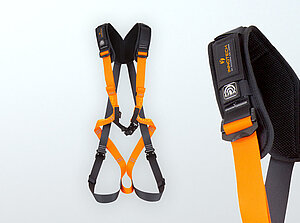
Personal Protective Equipment PPE
Secure connection between user and safety system
Whether on roofs, scaffolding, ladders, facades, or other fall-risk areas, compliant high-quality equipment for fall protection is an absolute must.
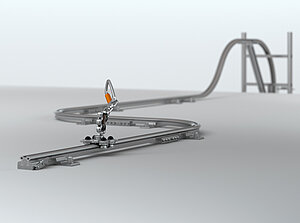
Rail System TAURUS
The strong and flexible rail system TAURUS
Curves, pitches, sloping positions, and of course straight runs: the TAURUS rail system is as versatile as the potential areas of application.
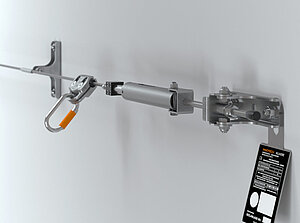
Lifeline Systems AIO
The powerful lifeline system that offers a whole host of variants
Our powerful AIO lifeline system provides a reliable and versatile solution.
Selection according to requirements, regulations and standards
When selecting the anti-fall PPE, it should always be ensured that a risk assessment is performed in order to identify all potential risks, and thus to derive the individual onsite requirements. As far as possible, the anti-fall PPE should be exactly matched to these requirements. In addition, the quality and functionality of the equipment naturally plays a very important role. Only high-quality products fulfil the necessary standards and provide reliable safety.
Because of the huge importance of these safety components, Europe also has its own regulation which governs all related legal details. It should also be remembered that all users must receive thorough training, both general and also specifically for the personal protective equipment used. This includes annual theoretical and practical refresher training. In addition, an occupational-medical health examination is a mandatory requirement.
European standards are similar, though they differ in detail. Here are the legal requirements for the DACH area (Germany, Austria and Switzerland):
- Deutsche Gesetzliche Unfallversicherung (German Social Accident Insurance - DGUV) – Use of Personal Protective Equipment against Falls from a Height
- Allgemeine Unfallversicherungsanstalt (Austrian accident insurance institution - AUVA) – Personal Protection(PPE)
- Schweizerische Unfallversicherungsanstalt (Swiss National Accident Insurance Organization - SUVA) – Anti-fall PPE: A lifesaver when used correctly
Compliance with the standards and requirements ensures that the anti-fall PPE works correctly and that the worker is protected effectively. In addition, compliance contributes to the legal protection of the employer.
Important characteristics of anti-fall PPE
However, not only should the anti-fall PPE fulfil the current requirements, it should also take future developments into account. In order to withstand the stresses during work, it needs to be tough and have a long working life. It is also important that it fits well and is comfortable to wear. Not least, the weight of the anti-fall personal protective equipment is also of importance – it should be light enough to allow comfortable working, yet provide sufficient protection from falls.
Training and inspection
It is also of great importance that the anti-fall PPE is always donned and used correctly. This is where training in the use and inspection of the equipment comes into play. INNOTECH provides solid, thorough training for the systems which it manufactures. In this training, the participants obtain adequate knowledge about the legal fundamentals and prescribed standards relating to the use of anti-fall PPE - for example the PSA-V, BauV, AM-VO and ASchG regulations.
The qualification of users is decisive, because accidents generally having serious consequences can be avoided only if the employees are able to use their equipment correctly and to quickly recognise possible indications of wear or damage. Only a competent person is capable of making these assessments. Responsible persons have to be aware of this.
Use of anti-fall PPE for rescuing people
For the quickest possible rescue of a fallen person suspended in their anti-fall personal protective equipment, a comprehensive, solid safety and rescue concept is required. It is also critical that regular training is provided in the steps of the rescue process defined in the concept, so that every action counts when the worst comes to the worst. After all, fatal risks have to be reckoned with.
Additionally, first aid measures should be implemented as quickly as possible after the rescue. And for this too, the employees require training. Training in rescue processes is necessary. The general rule is that rescued persons who are conscious should be cared for in a comfortable position. If the victim is unconscious, she/he should be brought into the recovery position, and help should be obtained immediately. If the vital functions cannot be detected, resuscitation measures must be instigated immediately. In all cases, the medical emergency service should be called at once.
Care and storage
For anti-fall personal protective equipment, correct care and storage of the equipment is of critical importance. This is the only way to ensure that the anti-fall PPE maintains its optimum performance and provides reliable protection. Incorrect handling or inappropriate storage can result in the equipment being damaged or no longer providing the necessary protection.
It is therefore necessary to take note of a number of practical tips. Firstly, it is important to follow exactly the manufacturer’s instructions for the cleaning and maintenance of the anti-fall PPE. In addition, regular inspections should be performed in order that potential indications of wear caused by ageing or damage are recognised in good time, so that the equipment can be replaced if necessary. Dry locations protected from solar radiation, such as the PSA-SCHRANK-W, are particularly suitable for the storage of personal fall protection systems.





